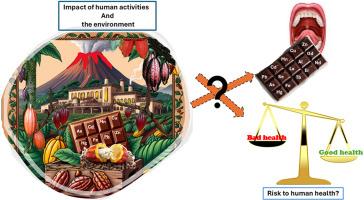Human health risk assessment and concentration of Al, Mn, Fe, Cu, Zn, Se, As, Cd, Pb, Hg, Rb, and REEs in chocolate
IF 3.5
3区 医学
Q2 FOOD SCIENCE & TECHNOLOGY
引用次数: 0
Abstract
This study aimed to determine trace element concentrations in chocolates with cocoa percentages ranging from ≤40 % to 92 %, and to assess nutritional risk based on estimated daily intake (EDI) and target hazard quotient (THQ). Thirty-two samples were analyzed for Al, Mn, Fe, Cu, Zn, Se, As, Cd, Pb, Hg, Rb, and rare earth elements using ICP-MS. The highest concentrations were found for Fe (438.23 mg kg−1), Cd (672.69 μg kg−1), and Ce (114.76 μg kg−1) in chocolates with 80–82 % cocoa. The maximum EDI values for Mn, Fe, Cu, Zn, and Se were 0.02, 0.78, 0.15, 0.03, and ≤0.0004 mg kg−1 BW day−1, respectively, in samples with 82 % and 95 % cocoa. The highest EDI values for Al and Rb were 0.04 and 0.19 mg kg−1 BW day−1, whereas for As, Cd, Hg, and Pb reached 0.02, 0.27, 0.01, and 0.03 μg kg−1 BW day−1, respectively, in chocolates with 70 % and 82 % cocoa, posing a human health risk. THQ values for Al, As, Cd, Hg, Pb, and Rb were <1. Principal component analysis showed a correlation between cocoa content, element concentration, and cocoa origin. These findings underscore the importance of monitoring both elemental concentrations and cocoa percentages to minimize toxic element exposure.

巧克力中Al、Mn、Fe、Cu、Zn、Se、As、Cd、Pb、Hg、Rb和ree的人体健康风险评价与浓度
本研究旨在测定可可含量≤40% ~ 92%的巧克力中微量元素的浓度,并基于估计每日摄入量(EDI)和目标危害商(THQ)来评估营养风险。采用ICP-MS对32份样品进行了Al、Mn、Fe、Cu、Zn、Se、As、Cd、Pb、Hg、Rb和稀土元素的分析。在可可含量为80% ~ 82%的巧克力中,铁(438.23 mg kg-1)、镉(672.69 mg kg-1)和镉(114.76 mg kg-1)的含量最高。在可可含量为82%和95%的样品中,Mn、Fe、Cu、Zn和Se的最大EDI值分别为0.02、0.78、0.15、0.03和≤0.0004 mg kg-1 BW day-1。在可可含量为70%和82%的巧克力中,Al和Rb的EDI值最高,分别为0.04和0.19 mg kg-1 BW d -1,而As、Cd、Hg和Pb的EDI值分别为0.02、0.27、0.01和0.03 μg kg-1 BW d -1,对人体健康构成威胁。Al、As、Cd、Hg、Pb、Rb的THQ值分别为
本文章由计算机程序翻译,如有差异,请以英文原文为准。
求助全文
约1分钟内获得全文
求助全文
来源期刊

Food and Chemical Toxicology
工程技术-毒理学
CiteScore
10.90
自引率
4.70%
发文量
651
审稿时长
31 days
期刊介绍:
Food and Chemical Toxicology (FCT), an internationally renowned journal, that publishes original research articles and reviews on toxic effects, in animals and humans, of natural or synthetic chemicals occurring in the human environment with particular emphasis on food, drugs, and chemicals, including agricultural and industrial safety, and consumer product safety. Areas such as safety evaluation of novel foods and ingredients, biotechnologically-derived products, and nanomaterials are included in the scope of the journal. FCT also encourages submission of papers on inter-relationships between nutrition and toxicology and on in vitro techniques, particularly those fostering the 3 Rs.
The principal aim of the journal is to publish high impact, scholarly work and to serve as a multidisciplinary forum for research in toxicology. Papers submitted will be judged on the basis of scientific originality and contribution to the field, quality and subject matter. Studies should address at least one of the following:
-Adverse physiological/biochemical, or pathological changes induced by specific defined substances
-New techniques for assessing potential toxicity, including molecular biology
-Mechanisms underlying toxic phenomena
-Toxicological examinations of specific chemicals or consumer products, both those showing adverse effects and those demonstrating safety, that meet current standards of scientific acceptability.
Authors must clearly and briefly identify what novel toxic effect (s) or toxic mechanism (s) of the chemical are being reported and what their significance is in the abstract. Furthermore, sufficient doses should be included in order to provide information on NOAEL/LOAEL values.
 求助内容:
求助内容: 应助结果提醒方式:
应助结果提醒方式:


